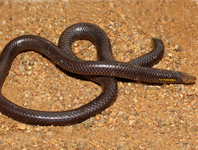Abstract
Argia angelae sp. nov. (Holotype ♂, BRAZIL, Mato Grosso, Chapada dos Guimarães, Rio Salgadeira (15°21'25" S, 55°49'51" W, 305 m), 1 xi 2015, D. S. Vilela leg., in LESTES, Cod. ACR 8173A) from Chapada dos Guimarães, Brazil is described, illustrated and diagnosed based on comparison with other known sympatric species of the genus. This species inhabits streams throughout the National Park and a map of its known distribution is provided.
References
Araújo, G.M., Amaral, A.F., Bruna, E.M. & Vasconcelos, H.L. (2013) Fire drives the reproductive responses of herbaceous plants in a Neotropical swamp. Plant Ecology, 214, 1479–1484.
https://doi.org/10.1007/s11258-013-0268-9Araújo, G.M., Barbosa, A.A.A., Arantes, A.A. & Amaral, A.F. (2002) Composição florística de veredas no Município de Uberlândia, MG. Revista Brasileira de Botânica, 25 (4), 475–493.
https://doi.org/10.1590/S0100-84042002012000012Calvert, P.P. (1902) Odonata. In: Godman, F.D. & Salvin, O. (Eds.), Biologia Centrali Americana—Insecta Neuroptera. R.H. Porter & Dulau Co., London, pp. 73–128.
Calvert, P.P. (1907) Odonata. In: Godman, F.D. & Salvin, O. (Eds.), Biologia Centrali Americana—Insecta Neuroptera. R.H. Porter & Dulau Co., London, pp. 309–404.
Calvert, P.P. (1909) Contributions to a knowledge of the Odonata of the Neotropical region, exclusive of Mexico and Central America. Annals of the Carnegie Museum, 6 (3), 73–280.
Fonseca, C.P. (2005) Caracterização dos Ecossistemas Aquáticos do Cerrado. In: Scariot, A., Sousa-Silva, J.C. & Felfili, J.M. (Eds.), Cerrado: Ecologia, Biodiversidade e Conservação. Ministério do Meio Ambiente, Brasília, pp. 25–44.
Françoso, R.D., Brandão, R., Nogueira, C.C., Salmona, Y.B., Machado, R.B. & Colli, G.R. (2015) Habitat loss and the effectiveness of protected areas in the Cerrado Biodiversity Hotspot. Natureza & Conservação, 13 (1), 35–40.
https://doi.org/10.1016/j.ncon.2015.04.001Fraser, F.C. (1946) Notes on Amazonian Odonata in the Leeds Museum. Transactions of the Royal Entomological Society of London, 96 (2), 11–46.
https://doi.org/10.1111/j.1365-2311.1946.tb00272.xGarrison, R.W. (1994) A synopsis of the genus Argia of the United States with keys and descriptions of new species, Argia sabino, A. leonorae, and A. pima (Odonata: Coenagrionidae). Transactions of the American Entomological Society, 120 (4), 287–368.
Garrison, R.W. (1996) A synopsis of the Argia fissa group, with descriptions of two new species, A. anceps sp. n. and A. westfalli sp. n. (Zygoptera Coenagrionidae). Odonatologica, 25 (1), 31–47.
Garrison, R.W., von Ellenrieder, N. & Louton, J.A. (2010) Damselfly Genera of the New World: An Illustrated and Annotated Key to the Zygoptera. The Johns Hopkins University Press, Baltimore, MD, 490 pp.
Garrison, R.W. & von Ellenrieder, N. (2013) A contribution to the study of the biodiversity of Odonata in Costa Rica with an emphasis on the genus Argia (Insecta: Odonata: Coenagrionidae). International Dragonfly Fund—Report, 62, 1–23.
Garrison, R.W. & von Ellenrieder, N. (2015) Damselflies of the genus Argia of the Guiana Shield (Odonata: Coenagrionidae). Zootaxa, 4042 (1), 1–134.
https://doi.org/10.11646/zootaxa.4042.1.1Garrison, R.W. & von Ellenrieder, N. (2017) New species of the damselfly genus Argia from Mexico, Central America and Ecuador with an emphasis on Costa Rica (Insecta: Odonata: Coenagrionidae). Zootaxa, 4235 (1), 1–93.
https://doi.org/10.11646/zootaxa.4235.1.1Gloyd, L.K. (1968a) The synonymy of Diargia and Hyponeura with the genus Argia (Odonata: Agrionidae: Argiinae). The Great Lakes Entomologist, 1 (8), 271–274.
Gloyd, L.K. (1968b) The union of Argia fumipennis (Burmeister, 1839) with Argia violacea (Hagen, 1861), and the recognition of three subspecies (Odonata). Occasional Papers of the Museum of Zoology University of Michigan, 658, 1–6.
Juen, L., Oliveira-Junior, J.M.B.D., Shimano, Y., Mendes, T.P. & Cabette, H.S.R. (2014) Composition and richness of Odonata (Insecta) in streams with different levels of conservation in a Cerrado-Amazonian Forest ecotone. Acta amazonica, 44 (2), 223–233.
https://doi.org/10.1590/S0044-59672014000200008Oliveira, P.S. & Marquis, R.J. (2002) Introduction: Development of Research in the Cerrados. In: Oliveira, P.S. & Marquis, R.J. (Eds.), The Cerrados of Brazil: Ecology and natural history of a neotropical savanna. Columbia University Press, New York, pp. 1–12.
https://doi.org/10.7312/oliv12042-introPereira-Mendes, T., Luiza-Andrade, A., Cabette, H.S.R. & Juen, L. (2017) How Does Environmental Variation Affect the Distribution of Dragonfly Larvae (Odonata) in the Amazon-Cerrado Transition Zone in Central Brazil? Neotropical Entomology, 1–9.
https://doi.org/10.1007/s13744-017-0506-2
Rambur, P. (1842) Histoire Naturelle des insectes: Neuropteres. Libraire Encydopedique de Roret, Paris, xvii + 534 pp.Riek, E.F. & Kukalová-Peck, J. (1984) A new interpretation of dragonfly wing venation based upon Early Upper Carboniferous fossils from Argentina (Insecta: Odonatoidea) and basic character states in pterygote wings. Canadian Journal of Zoology, 62 (6), 1150–1166.
https://doi.org/10.1139/z84-166Selys-Longchamps, Edm. De. (1865) Synopsis des Agriones, 5me légion: Agrion. Bulletin de l'Académie Royale des Sciences, des Lettres et des Beaux-arts de Belgique, Série 2, 20 (8), 375–417.
Vilela, D.S., Guillermo-Ferreira, R. & Del-Claro, K. (2016) The Odonata community of a Brazilian vereda: seasonal patterns, species diversity and rarity in a palm swamp environment. Bioscience Journal, 32, 486–495.
https://doi.org/10.14393/BJ-v32n2a2016-30491

